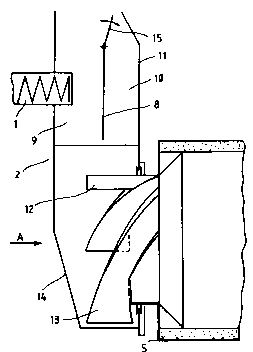Some of the information on this Web page has been provided by external sources. The Government of Canada is not responsible for the accuracy, reliability or currency of the information supplied by external sources. Users wishing to rely upon this information should consult directly with the source of the information. Content provided by external sources is not subject to official languages, privacy and accessibility requirements.
Any discrepancies in the text and image of the Claims and Abstract are due to differing posting times. Text of the Claims and Abstract are posted:
| (12) Patent: | (11) CA 2063390 |
|---|---|
| (54) English Title: | FEEDING SYSTEM FOR A LIME REBURNING KILN |
| (54) French Title: | SYSTEME D'ALIMENTATION POUR FOUR A CHAUX |
| Status: | Term Expired - Post Grant Beyond Limit |
| (51) International Patent Classification (IPC): |
|
|---|---|
| (72) Inventors : |
|
| (73) Owners : |
|
| (71) Applicants : |
|
| (74) Agent: | GOWLING WLG (CANADA) LLPGOWLING WLG (CANADA) LLP |
| (74) Associate agent: | |
| (45) Issued: | 1995-08-08 |
| (86) PCT Filing Date: | 1990-06-28 |
| (87) Open to Public Inspection: | 1991-01-04 |
| Examination requested: | 1991-12-30 |
| Availability of licence: | N/A |
| Dedicated to the Public: | N/A |
| (25) Language of filing: | English |
| Patent Cooperation Treaty (PCT): | Yes |
|---|---|
| (86) PCT Filing Number: | PCT/FI1990/000172 |
| (87) International Publication Number: | WO 1991000251 |
| (85) National Entry: | 1991-12-30 |
| (30) Application Priority Data: | ||||||
|---|---|---|---|---|---|---|
|
A method and apparatus for heat treatment of lime mud com-
prises drying of the lime mud to be introduced into the lime reburn-
ing kiln (5) in a pneumatic dryer (3) by means of flue gases dis-
charged from the lime reburning kiln in order to regenerate the lime
content of the lime mud. From a drying filter (6), the lime mud
thickened to a dry solids content of over 75 %, preferably to 80 %, is
introduced into a feed chamber (2) through which an adjustable por-
tion of the flue gas is conducted. Depending on the gas amount, 100
% or less of the lime mud is entrained with the gas into the dryer (3),
the remaining portion falling into the lower section (14) of the feed
chamber, wherefrom it is further transferred into the lime reburning
kiln (5).
Note: Claims are shown in the official language in which they were submitted.
Note: Descriptions are shown in the official language in which they were submitted.

2024-08-01:As part of the Next Generation Patents (NGP) transition, the Canadian Patents Database (CPD) now contains a more detailed Event History, which replicates the Event Log of our new back-office solution.
Please note that "Inactive:" events refers to events no longer in use in our new back-office solution.
For a clearer understanding of the status of the application/patent presented on this page, the site Disclaimer , as well as the definitions for Patent , Event History , Maintenance Fee and Payment History should be consulted.
| Description | Date |
|---|---|
| Inactive: Expired (new Act pat) | 2010-06-28 |
| Inactive: IPC from MCD | 2006-03-11 |
| Inactive: IPC from MCD | 2006-03-11 |
| Letter Sent | 2000-06-14 |
| Grant by Issuance | 1995-08-08 |
| Request for Examination Requirements Determined Compliant | 1991-12-30 |
| All Requirements for Examination Determined Compliant | 1991-12-30 |
| Application Published (Open to Public Inspection) | 1991-01-04 |
There is no abandonment history.
| Fee Type | Anniversary Year | Due Date | Paid Date |
|---|---|---|---|
| MF (patent, 8th anniv.) - standard | 1998-06-29 | 1998-05-11 | |
| MF (patent, 9th anniv.) - standard | 1999-06-28 | 1999-05-12 | |
| MF (patent, 10th anniv.) - standard | 2000-06-28 | 2000-05-15 | |
| Registration of a document | 2000-05-18 | ||
| MF (patent, 11th anniv.) - standard | 2001-06-28 | 2001-05-16 | |
| MF (patent, 12th anniv.) - standard | 2002-06-28 | 2002-05-15 | |
| MF (patent, 13th anniv.) - standard | 2003-06-30 | 2003-05-14 | |
| MF (patent, 14th anniv.) - standard | 2004-06-28 | 2004-05-17 | |
| MF (patent, 15th anniv.) - standard | 2005-06-28 | 2005-05-16 | |
| MF (patent, 16th anniv.) - standard | 2006-06-28 | 2006-05-15 | |
| MF (patent, 17th anniv.) - standard | 2007-06-28 | 2007-05-17 | |
| MF (patent, 18th anniv.) - standard | 2008-06-30 | 2008-05-15 | |
| MF (patent, 19th anniv.) - standard | 2009-06-29 | 2009-06-11 |
Note: Records showing the ownership history in alphabetical order.
| Current Owners on Record |
|---|
| AHLSTROM MACHINERY OY |
| Past Owners on Record |
|---|
| ARTO AHVENAINEN |